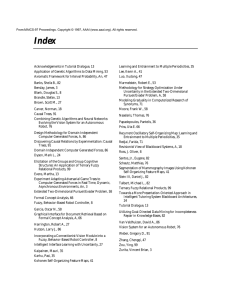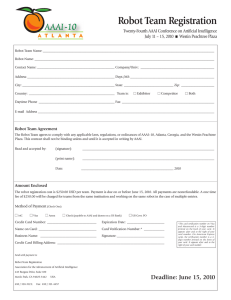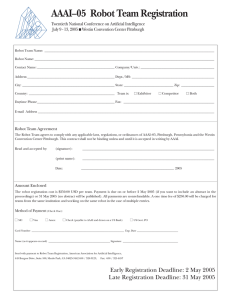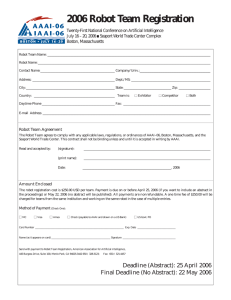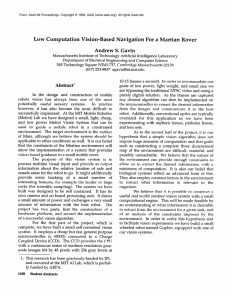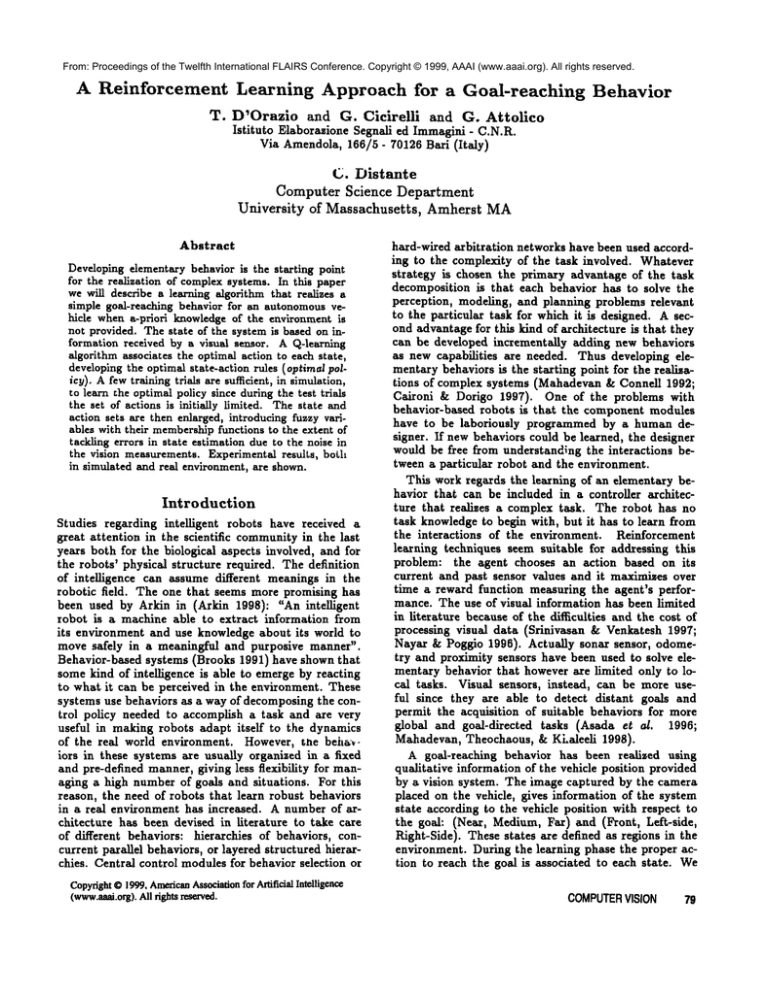
From: Proceedings of the Twelfth International FLAIRS Conference. Copyright © 1999, AAAI (www.aaai.org). All rights reserved.
A Reinforcement
Learning Approach for a Goal-reaching
Behavior
T. D’Orazio
and G. Cicirelli
and G. Attolico
Istituto Elaborazione Segnali ed Immagini - C.N.R.
Via Amendola, 166/5 - 70126 Bari (Italy)
C. Distante
Computer Science
Department
University of Massachusetts,Amherst MA
Abstract
Developingelementary behavior is the starting point
for the realization of complexsystems. In this paper
we win describe a learning algorithm that realizes a
simple goal-reaching behavior for an autonomousvehicle whena-priori knowledgeof the environment is
not provided. The state of the system is based on information
received
by a visualsensor.
A Q-learnlng
algorithm
associates
theoptimal
action
toeachstate,
developing
theoptimal
state-action
rules
(optimal
policy).
A fewtraining
trials
aresufficient,
insimulation,
tolearn
sheoptimal
policy
since
during
thetesttrials
thesetofactions
isinitially
limited.
Thestate
and
action
setsarethenenlarged,
introducing
fuzzyvariables
withtheir
membership
functions
totheextent
of
tackling
errors
instate
estimation
duetothenoise
in
thevision
measurements.
Experimental
resuILs,
both
insimulated
andrealenvironment,
areshown.
Introduction
Studies regarding intelligent
robots have received a
great attention in the scientific communityin the last
years both for the biological aspects involved, and for
the robots’ physical structure required. The definition
of intelligence can assume different meanings in the
robotic field. The one that seems more promising has
been used by Arkin in (Arkin 1998): "An intelligent
robot is a machine able to extract information from
its environment and use knowledge about its world to
move safely in a meaningful and purposive manner".
Behavior-based systems (Brooks 1991) have shown that
somekind of intelligence is able to emerge by reacting
to whatit can be perceived
in theenvironment.
These
systems
usebehaviors
as a wayof decomposing
thecontrolpolicyneededto accomplish
a taskand arevery
usefulin makingrobotsadaptitselfto the dynamics
of therealworldenvironment.
However,
tttebeiLa,iorsin thesesystems
areusually
organized
in a fixed
andpre-defined
manner,
giving
lessflexibility
formanaginga highnumberof goalsandsituations.
Forthis
reason,
theneedof robotsthatlearnrobustbehaviors
in a realenvironment
hasincreased.
A numberof architecture
hasbeendevised
in literature
to takecare
of different
behaviors:
hierarchies
of behaviors,
concurrent
parallel
behaviors,
or layered
structured
hierarchies.
Central
control
modules
forbehavior
selection
or
Copyright
©1999,American
Association
for ArtificialIntelligence
(www.anai.org).
Allrightsreserved.
hard-wired arbitration networks have been used according to the complexity of the task involved. Whatever
strategy
is chosentheprimaryadvantage
of the task
decomposition
is thateachbehavior
has to solvethe
perception,
modeling,
andplanning
problems
relevant
to theparticular
taskforwhichit is designed.
A secondadvantage
forthiskindof architecture
is thatthey
can be developed
incrementally
addingnew behaviors
as newcapabilities
areneeded.Thusdeveloping
elementary
behaviors
is thestarting
pointfortherealizationsof complexsystems(Mahadevan
& Connell1992;
Caironi& Dorigo1997).One of the problemswith
behavior-based
robotsis thatthe component
modules
have to be laboriously
programmedby a humandesigner.
If newbehaviors
couldbe learned,
thedesigner
wouldbe freefromunderstanding
theinteractions
betweena particular
robotandtheenvironment.
This work regards the learning of an elementary behavior that can be included in a controller architecture that realizes a complex task. The robot has no
task knowledgeto begin with, but it has to learn from
the interactions
of the environment. Reinforcement
learning techniques seem suitable for addressing this
problem: the agent chooses an action based on its
current and past sensor values and it maximizes over
time a reward function measuring the agent’s performance. The use of visual information has been limited
inliterature
because
ofthedifficulties
andthecostof
processing
visualdata(Srinivasan
& Venkatesh
1997;
Nayar& Poggio1996).Actuallysonarsensor,odometryandproximity
sensors
havebeenusedto solveelementarybehavior
thathowever
arelimited
onlyto localtasks. Visual sensors, instea~i, can be more useful since they are able to detect distant goals and
permit the acquisition of suitable behaviors for more
global and goal-directed tasks (Asa~ia et al. 1996;
Mahadevan, Theochaous, & Ki.aleeli 1998).
A goal-reaching behavior has been realized using
qualitative information of the vehicle position provided
by a vision system. The image captured by the camera
placed on the vehicle, gives information of the system
state according to the vehicle position with respect to
the goal: (Near, Medium, Far) and (Front, Left-side,
Right-Side). These states are defined as regions in the
environment. During the learning phase the proper action to reach the goal is associated to each state. We
COMPUTER
VISION
79
From: Proceedings of the Twelfth International FLAIRS Conference. Copyright © 1999, AAAI (www.aaai.org). All rights reserved.
use a Q-learning
algorithm,
a formof model-free
reinforcement
learning
basedon a stochastic
dynamicprogramming,to find the optimalstate-action
mapping.
The learningphasehas been executedin simulation,
afterwards
a testing
phasehas beencarriedoutin both
simulation
and realexperiments.
In the testingphase
theknowledge
learned
is checked
by forcing
thevehicle
to choosealwaysthe optimal
actions
in eachstatewhile
it performs
somepathsfromdifferent
starting
positions
to the goal.The pathsobtainedhaveabruptchangesof
directions
becauseof the limitedactionspaceand the
stateclassification
used.Besidesin the realenvironment the noisein imagedata does not allowaccurate
estimates
of theactualstatesof thevehicle.
Theseconsiderations
brought
us to theintroduction
of transition
areasbetweenthe regionsof the environment
and to a
newdefinition
of thestateof therobot.Fuzzyvariables
withtherelative
membership
functions
havebeenintroducedto computeboth the statesand the corresponding actionsthat have to be performedby the robot.
Thisdetermines
a gradualchangeof the robot’sstate
throughadjacent
regionsand an increase
of the number
of actions.
As a consequence
duringthe navigation
the
robotperformssmoothpaths.
Thepaperis organized
as follows.
Thefollowing
sectiondefinesthe elementary
behavior
givinga fulldescription
of thestateandactionsetsusedin thelearning algorithm.
Successively
the experiments,
realized
withboththe simulated
and the realrobot,are shown.
Rcsuhsobtainedwith and withoutthe fuzzy regions
extension
are also compared.
Finallysomeconclusions
are drawn.
The Elementary
State
Set
Thissection
definesthe stateof the systemand howit
is obtained.
Sincethe aim of thisworkis to testthe
learning
algorithm
whenonlyqualitative
information
is
available,
we useda simplequantitative
information
obtainedfroma visualsystem.
The trickusedis described
as follows:the environment
has been splitin regions,
80
D’ORAZIO
(;t)AI.
I
i
NEAR
.............
i
J
, ......................
MI,:I)IL Xl
!
Behavior
In thispaperwe present
a methodof vision-based
reinforcement
learningfor an elementary
goal-reaching
behaviorin a closedandfreeenvironment.
The robotdoes
not need any information
aboutthe environment.
The
imagecapturedfrom the cameramountedon the robot
is theonlysourceof inputfor thealgorithm.
Once the goal state has been fixed, an analysis of
the input image allows the detection of the current system state st relative to the goal state. An action at
is selected by using an action selection function. The
robot performs the action at in the state sl and it enters in the new state st+l. The environment returns a
reward value rt which judges the just executed action.
Using this information the learning algorithm updates
the control policy which maximizes the expected discounted sum of future reinforcements.
The algorithm
used to find this optimal policy is the well known Q¯ Learning algorithm (Watkins & Dayan 1992).
The
as shown in Fig. 1, representing the state of the vehicle. In particular the state st at time t is defined as the
couple (i, j) where i E {LEFT-SIDE,FRONT,RIGHTSIDE},
j E {NEAR,MEDIUM,FAR}.
The state
(FRONT,NEAR)has been fixed as the goal state. The
visual system localizes the robot in one of the regions of the environment using a simple self-location
method. This method, described in detail in (E.Stella
& A.Distante 1995), estimates the robot position in an
absolute coordinate system (X - Y) using three landmarks of the environment.
In orderto speedup the
statedetection
phase,artificial
landmarks
{infrared
led)
have bccnplacedin the environment
sincetheiridentification
in the imageis simpleand fast.A landmark
trackingmodulefor keepingthe landmarks
centeredin
the imagehas also been implemented.
FAR
LEFT-SIDE
FRONT
RIG H’I’-SIDE
Figure 1: State Space
The
Action
Set
and
Q-learning
This section describes the core of the learning process:
the mapping from states to actions required for solving the considered task. The action space is discrete
and contains eight actions corresponding to the absolute orientations that the agent can take in each state:
.4 = {0, 45, 90, ..., 315} (degrees). Performing one action means that the vehicle rotates until it is oriented
towards the selected direction and translates until the
current state changes.
The purpose of the learning process is to learn for
each state st the best action at. The learning algorithm
used to find this mapping is the Q-learning algorithm
(Watkins & Dayan 1992). This is based on the estimation of the real-valued function Q(st,a+) that gives
the expected discounted sum of future reinforcement for
performing action at in state st. At each time step the
From: Proceedings of the Twelfth International FLAIRS Conference. Copyright © 1999, AAAI (www.aaai.org). All rights reserved.
value of the estimate Q(st, at) is updated as follows:
theNomadic
Inc.Thesimulated
environment
hasbeen
delimited
according
to therealenvironment
making
the
+-(1
+ +
b)) successive
transfer
ofthelearned
policy
fromthesimupossible.
(I) latedtotherealtest-bed
where s,+1is the next state after taking action a~ in
Ateachstepthecurrent
states iscomputed
byusing
state st, c~ is the learning rate (0 _~ a < 1), 7 is a distheinformation
received
by therobotposition,
thenan
count factor (0 < "7 < 1), r, the reinforcement value.
action
a is selected
andperformed
bringing
therobot
This value is an evaluation of the current system perin a newstate.TheQ(s,a)Q-values
areupdated
acformancewhich can be successful or not in relation to
cording
to the(I)formula.
Inorderto obtain
a dense
the desired behavior. In our application the system rematrix
oftheQ-values
a number
oftrials
hasbeenreceives r4 = 1 if it reaches
thegoal-state,
r, = -Iif
peated
toguarantee
thevisit
ofallthestates.
A trial
is
it bumpsintoa wallandrt = 0 inalltheotherstate
theexecution
of a number
ofpathsfromdifferent
starttransitions.
Thisisa sortofdelayed
rein/orcement
used
ingpositions
fixedin theenvironment.
Eachpathcan
inthose
applications
where
itisdifficult
toevaluate
the
terminate
witha success
if thegoal-state
isachieved
or
performance
of thesystemat eachstep.In ourcase
witha failure
ifa collision
occurs.
The starting
posireinforcements
areavailable
onlywhentheperforming tions
considered
are22different
points
attheborders
of
system
achieves
given
states,
i.e.either
whenitenters
theenvironment.
Theenvironment
is 140inches
wide
thegoal-state
(reward)
or whenit bumpsintoa wall
and200inches
long.Duringthesimulation,
after20
(penalty).
trials,
wehaveverified
thattheQ-values
reached
their
Theaction
selection
is carried
outin thefollowing stablevalues.
Fig.2 showstheoptimal
actions
(i.e.
way.Wheneverthe systemencounters
a newstatea
withthehighest
Q-value),
obtained
afterthislearning
random
selection
withuniform
distribution
is applied
phase:
thedotted
lines
delimits
thestates
ofthesystem
to thesetof theeightpossible
actions.
A stochastic in theenvironment,
ineachstatetheorientation
that
selection,
withtheBoltzmann
distribution,
is applied
hastobetakenby therobotis depicted.
whenthesystem
is in a statealready
visited.
Indeed
theprobability
ofchoosing
theaction
atinthestate
st
depends
on theQ-value
Q(st,at)asfollows:
eqC,,al/T
=a,ls=s,)
=E.eqC’,’)/T(2)
whereT is thetemperature
parameter.
TheBoltzmann
distribution
permits
a smooth
transition
frompureexploration
to exploitation
as theexperiment
goeson.
Thisis donetuningopportunely
thetemperature
parameter
fromhigher
tolowervalue.
The Experiment
A numberof experiments
havebeenperformed
to test
thevisual
goal-reaching
behavior
described
in theprevioussections.
A simulation
phaseanda testing
phase
have been considered. In the simulation phase the stateaction
mapping
is completely
learned,
whileinthetestingphasetheoptimality
of theacquired
behavior
is
evaluated
in boththesimulated
andrealenvironment.
The robot
A Nomad200platform, that integrates a mobile robot
system
withseveral
sensory
modules,
hasbeenusedin
ourexperiments.
Onlytwosensory
systems
areconsidered:the20tactile
sensors
mounted
around
thebodyof
thevehicle
andthevideocamera
mounted
on a pan/tilt
headon thetopof thevehicle.
Thetactile
sensors
candetect
collisions
withthewalls
in theenvironment,
whilethecameracontinuously
captures
imagesof the
environment.
Thepan/tilt
headcanrotate
174degrees
horizontally
and70degrees
vertically.
The Simulation Phase
The described
learning
procedure
hasbeeninitially
experimented
using the Nomad2O0
simulator provided by
Figure2: ’Optimal
actions
learned
afterthelearning
phase in simulation.
The Testing
Phase
Duringthe testing
phasethelearning
algorithm
is
switched
offanda number
ofpathsareperformed
bythe
agentin bothsimulated
andrealenvironment.
Fig.3
showssomesimulated
pathsobtained
afterthecompletionof thelearning
phase.
COMPUTER
VISION
81
From: Proceedings of the Twelfth International FLAIRS Conference. Copyright © 1999, AAAI (www.aaai.org). All rights reserved.
of the regions where small errors in the position estimation may result in a wrong evaluation of the actual
state. Therefore we decided to define transition areas
between the regions (see fig.4) adopting a fuzzy model
for the state definition. Fuzzy sets are a powerful tool
for representing sets with fuzzy boundaries. We have
considered two fuzzy variables: X ranging in the set
{LEFT- SIDE, FRONT, RIGHT - SIDE} and Y
ranging
in the set {NEAR, MEDIUM, FAR} where
the six labels denote the fuzzy sets shown in Fig. 5.
t;OAl.
I,EF’r.SIDE
FRONT
RICII’I’-SII)E
.~...
/
\
__/._
x,j
%1
NEAR
’.
%1 &j
),,,
%J
X$
,
. ;
GOAL~
~,I EI)I U.%I
FAR
II
Figure 3: Simulated paths
",.......... ~
&2
¯ ,,
~/--
/
\,_
/
//____
A\
/
)
J
%"
Y4
NEAR
Figure5: Respectively
membershipfunctionsof the
fuzzyvariables
X (a) and Y (b).
.......... ... ......
)I............
:
: .........
[’7:77.
MEDIUM
! i.............
~ :i: ~-....
......
~
i .........
Y"i".......
.. , .. ........ - ........
FAR
¯ I.FF"I’-NII)F
.
v
FRONT
KI(J II’r-sII)E
Figure4: StateSpacewithtransition
areas
In order to examine the optimality of the trajectories
found by the robot, the paths are performed by forcing
the choice of the optimal actions. The abrupt changes
of the actions taken by the robot in Fig. 3 are due to
both the limited action space and the splitting of the
environment into regions. In a real environment the inaccurate estimation of the actual state, due to the peculiarity of visual information, develops the same type of
discontinuities.
This happens above all at the borders
82 D’ORAZIO
In thefigurethe rangesof the continuous
valuesfor
eachfuzzyset are also displayed,
they are delimited
by the symbolszk and Yk (k -- 0... 5). Thesevalues
havebeenfixedheuristically
according
to the errorin
the robotpositionestimation.
Each continuous
value
can belongto a fuzzy set with a degreeof membership~ in the range[0, l].The membership
functions
of
the X and Y fuzzyvariables
are shownrespectively
in
Fig. 5(a) and (b). With the introduction of membership
functions a given value z is no more considered as completely
LEFT- SIDE, FRONT or RIGHT - SIDE
but if the value z is in the range [z0, zz] it is considered
as completely LEFT- SIDE (D(z) = l), whereas
is in the range [zl, z2] it is considered as LEFT-SIDE
with a given ~= value and as FRONTwith a 1 - ~z=
value and so on. The interesting
property of fuzzy
sets admits the partial overlapping of their membership
functions with a gradual change in the classification
of
contiguous values as belonging to adjacent regions. The
state of the system is now defined by the quadruple
(i,j,~i,/~#),
where i and j are the same as described
in the section "The State Set" and represent two fuzzy
sets, whereas /~, and /~i are the values of membership
of the z y position values to the i j fuzzy sets. As a
result an action a* is now computed according to the
formula:
From: Proceedings of the Twelfth International FLAIRS Conference. Copyright © 1999, AAAI (www.aaai.org). All rights reserved.
GOAL
(3)
ffi are the optimalactionsshown
wherea~"ffiand a~+~
in Fig. 2 of the two adjacentregionsi and i q- I in
the ordered
set {LEFT - SIDE, FRONT, RIGHT SIDE), whereas a~ ~* and a~ are the same but with
j in the set {NEAR, MEDIUM, FAR). As a result
the set of actions becomes continuous. The new definition of the system state and the new action space allow
the robot to perform smooth paths as we can see in figures 6 and 7 in both the simulated and real test-beds.
GOAL
Figure7: Real pathswiththe fuzzyregionsextension
Acknowledgements
/ _.t....
Figure 6: Simulated paths with the fuzzy regions extension
Conclusions
This work claims that it is possible to learn good action strategies, from reinforcement, for vision-based systems moving in a real and noisy environment. We have
shown that the state-action
map learned in simulation
can be used in a real navigation: the vehicle exhibits
a goal reaching behavior even if the current position is
not clearly known. The introduction of fuzzy regions
allow the selection of proper actions according to the
memberships values for each region. This elementary
behavior can be joined to other behaviors (e.g. obstacle avoidance, escaping from collision, and so on) in
complex navigation context. As this module depends
on a vision system it has the great advantage of being
reliable also for long time navigation; on the contrary,
goal reaching behaviors based on information provided
by odometers
becomeunsuitable,
aftera while,for the
cumulative
errors.
The authors are grateful to Mr. L. Capozzo for the
technical support during the experimental phase.
References
Arkin, R. 1998. Behavior-Based Robotics. The MIT
Press, Cambridge, Massachusetts.
Asada, M.; Noda, S.; Tawaratsumida, S.; and Hosoda,
K. 1996. Purposive behavior acquisition
for a real
robot by vision-based reinforcement learning. Machine
Learning 279.
Brooks, R. 1991. Intelligence
without reason. Technical report, Massachusetts Institute of Technology.
A.I.Memo 1293.
Caironi, P., and Dorigo, M. 1997. Training and delayed reinforcement
in q-learning
agents.
International
Journal of Intelligent Systems in press.
E.Stella,
and A.Distante. 1995. Self-location
of a
mobile robot by estimation of camera parameters.
Robotics and Autonomous System 15.
Mahadevan, S., and Connell, J. 1992. Automatic
programming of behavior-based robots using reinforcement learning. Artificial Intelligence 311-385.
Mahadev&n, S.; Theochaous, G.; and Khaleeli,
N.
1998. Rapid concept learning for mobile robots. Machine Learning. in press.
Nayar, S., and Poggio, T. 1995. Early Visual Learning.
Oxford University Press.
Srinivasan, M. V., and Venkatcsh, S. 1997. From living
Eyes to Seeing Machines. Oxford University Press.
Watkins, C. J., and Dayan, P. 1992. Technical note q-learning.
Machine Learning 8(3/4):323-339.
COMPUTER
VISION
83

